Stop garden pests and reduce the damage to your vegetables crops organically, without spraying insecticides by using umbellifer herbs strategically as companion plants in your vegetable garden. These herbs attract beneficial insects that feast on garden pests, reducing their population and giving you better vegetable yields.
I surveyed my readers to find out what their biggest struggle with their gardens was. Overwhelmingly, the answer came back as struggles with garden pests that ruin the crop. These ranged from Japanese beetle, corn worm, squash bugs, cabbage butterfly caterpillars, slugs, rabbits, and deer.
- Elise asked, ” How do you get rid of tomato worms before they eat your plants? Every year my plants are doing great then all of the sudden tomato worms are eating them “
- Tracy said, ” Squash bugs… Bane of my garden. I’d love to find a non-toxic, reasonable way to keep them at bay or extinguish them all together.”
- Pat echoed the frustration, ” Squash Vine Borers! My squash and zucchini will just get going and making fruit, and all of a sudden the plants go down. I do not seem to be able to out fox them and keep my plants going. “
Maybe you’ve had a similar experience with bugs in your garden.

When it comes to insect garden pests, hand picking and crop covers, are a labor intensive way to deal with it. You can hand pick the eggs and early stages of the larvae off your plants, interrupting the egg laying cycle. I used to do that. When my kids were little, I paid them 5 cents a bug, that they drowned in a bucket of soapy water. One of my homestead friends recommends using duct tape to stick it to the bugs. But I discovered another way that is way less work.

Many of these garden pests have a natural enemy in the garden — the parasitic wasp. These wasps don’t sting and you actually want them in your garden. These wasps lay their eggs in the larvae stage of insect pests like cabbage butterflies, squash bugs (actually a moth), and tomato horn worms. As these eggs hatch they consume the garden pest, freeing your garden of the problem. And once they arrive in your garden, given the right environment, they tend to stick around year after year.
Brachonid wasps are small, usually less than 1/2 inch long. They have narrow waists. Instead of a stinger they have a long black ovipositor on their rear end that deposits eggs on the soft bodies of caterpillars. If you see caterpillars with white cocoons all over their bodies, don’t kill them. These white cocoons are the pupae stage of brachonid wasps. Leave these infected garden pests to allow the wasp larvae to hatch and continue to live in your garden. You’ll be investing in long term garden pest control.
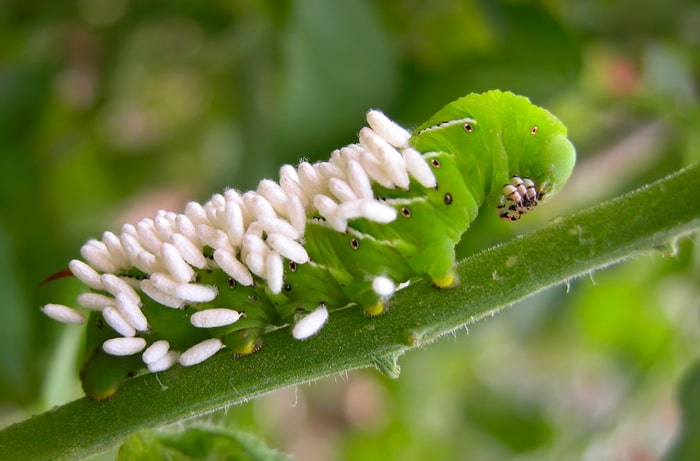
Some folks actually buy these predatory wasps at the garden store to add to their garden to control garden pests, but there is a better way. Companion planting with herbs is like putting out a “Welcome” sign to these beneficial insects. If they are in your area, they will come.
Learn more about the herbs to grow to attract these predatory insects to your garden — insects like soldier beetles, assassin bugs, predatory wasps, lady bugs, and praying mantis in my post, “Companion Planting with Herbs“. In this post you’ll discover the special role umbellifer plants like dill, Daucus flowers, yarrow, and fennel have in companion planting. You’ll also learn about herbs that heal the soil, and nurse-herbs that help plants near them grow better. Growing umbellifer plants in your vegetable garden actually attracts these beneficial predatory wasps, reducing the damage that caterpillars and worms do to your garden vegetables. Over several seasons, when you continue to provide breeding grounds and nectar for these beneficial insects, by growing umbellifer flowers and herbs, you’ll find your garden pest population decreasing with much less damage to your vegetables.
Ideally you’ll want to plant these herbs and flowers close to where your vegetable garden is. I plant a row of dill between my rows of kale, broccoli, and cabbage to get the full benefits of these predatory wasps. While I still get a few holes in my outer cabbage leaves the damage is 10 times less than before I planted dill this way and doesn’t ruin the harvest.
Companion planting can also help with discouraging rabbit and deer damage, but ideally you’ll want to pair that strategy with a sturdy fence with rabbit wire that is buried below ground level to discourage the diggers.
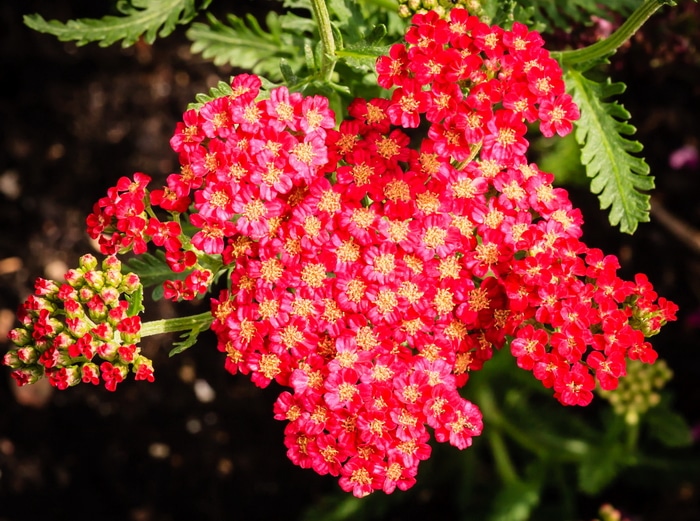
These companion herbs are not just for pollinators and bugs though. They are also powerful culinary and medicinal herbs that you can use in the kitchen and in your herbal apothecary.
Common dill, for instance, is the plant to grab for infant colic — gripe water is a traditional infant remedy to calm that screaming newborn that is in pain — it works within minutes to relieve gas and discomfort. It works on adults too, for indigestion and gas. Even just chewing some dill seed can support digestion. Dill is a great companion plant for cabbages, broccoli, and cauliflower. You’ll find a reduction in leaf damage when dill is nearby your Kole plants.
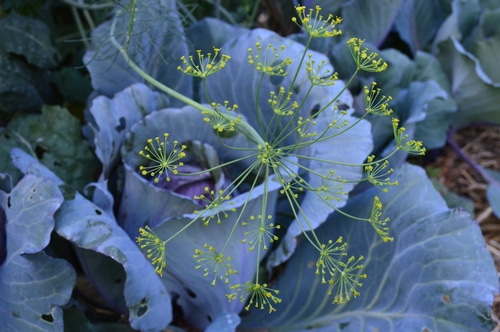
Yarrow, one of the nurse-plants that actually heals plants growing near it, is a powerful remedy for cuts and bruises. We proved its power one year when Mr. Joybilee crushed his finger under a loaded wheel barrow when he slipped on the ice. The finger swelled up and it looked like his nail was going to pop off from the internal pressure. But we soaked a cotton cloth in yarrow tincture and wrapped up the finger. Within 30 minutes the swelling had completely subsided. And much of the pain was gone. He didn’t even lose the nail. A couple days later he couldn’t remember which finger he had bruised. A salve made with yarrow eases bruises and sprains quickly. Grab my recipe now so that you have it next time you need it.
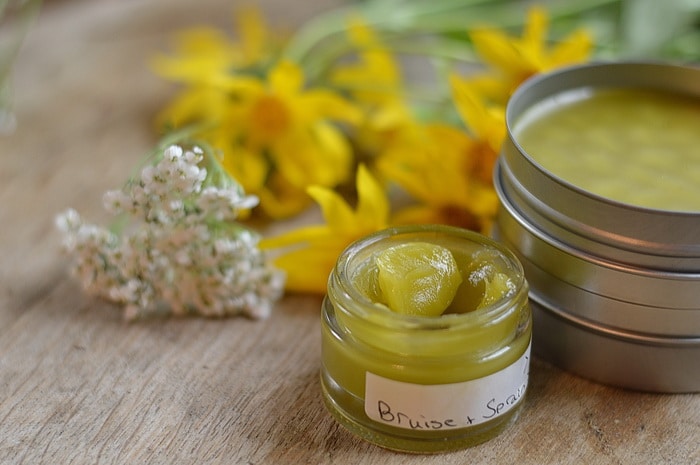
You can use wild white or pink yarrow for this or even the pretty red or orange yarrow in your flower bed. If it’s growing organically in your garden it will be powerful and effective.
Stop garden pests and reduce the damage to your vegetables crops organically, without spraying insecticides by using umbellifer herbs strategically as companion plants in your vegetable garden. These herbs attract beneficial insects that feast on garden pests, reducing their population and giving you better vegetable yields.
More ways to get rid of garden pests naturally
Carpenter ants can be an issue in any garden that includes wooden supports, wooden garden beds, or even a wooden garden shed. Learn How to Get Rid of Carpenter Ants without resorting to highly toxic ant killer sprays, dangerous chemicals, or burning down everything they’ve touched. The same ant control tactics for Carpenter ants can also work with fire ants and the tiny little black ants too.
Along with hand picking some insects, an Insecticidal Soap Spray for Garden Pests can make handling winged and crawling garden pests a lot easier. Use the soap spray in a bottle to knock pests off plants, or in a container to help with hand picking caterpillars, Japanese beetles, potato beetles, squash bugs, and more.
Outside of getting rid of pests by hand, you can invite nature to help you control them. Invite Hummingbirds to Your Garden for Insect Control, as they love small gnats and mosquitoes. Hummers don’t just eat nectar, they need the protein of small insects too and your garden can be a great spot for them to have a smorgasbord.
Other birds you can invite to your garden include swallows and bluebirds. These beautiful birds love insects just as much as teh hummers. So, Invite Swallows and Bluebirds to Your Garden for Insect Control and have a lower mosquito population too!
Our last friendly critter allies include frogs and toads. Give them a cool, sheltered spot and some fresh misting water and you’ll have happy campers that enjoy snacking on bugs, grubs, and more. Invite frogs and toads to your garden for grub and beetle control. The same habitat that invites frogs and toads can also encourage garter snakes, who love snacking on tasty voles and mice that can destroy your crops too. Voles and mice sometimes hide in straw mulches, but there are other weed control methods that don’t provide extra cover for pests.
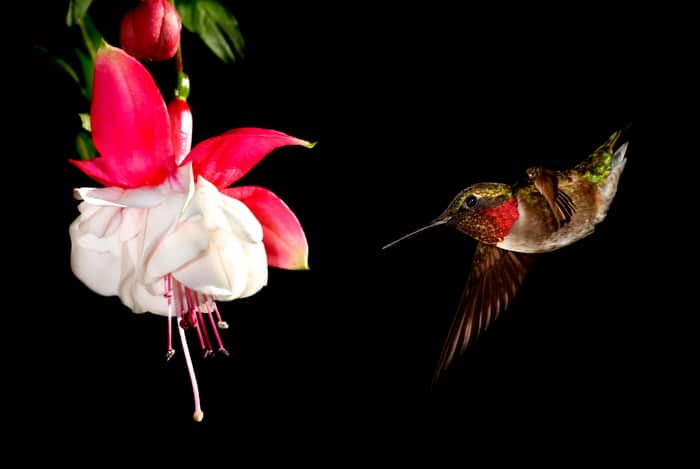
Let me show you how to get more hummingbirds
I created this short ebook to help you attract more hummingbirds to your garden. Download it now for FREE.
The ebook, How to Attract Hummingbirds to Your Garden offers tips to help you welcome more hummingbirds into your garden and information to help YOU enjoy them more.
In this short ebook you’ll learn:
- 25 little known hummingbird facts
- The best flowers to plant to keep them coming back year after year
- The best hummingbird feeders to use to keep these tiny birds healthy and protect them from injury
- How to keep ants and bees out of the hummingbird feeder
- The best recipe for the healthiest hummingbird nectar
- Why some folks use fake science to keep you buying GMOs
- What hummingbirds eat beside sugar water
- How to support our native hummingbirds so they don’t become endangered
- What else besides sugar water you need to have in your garden so they can raise their babies safely
- How hummingbirds can make YOU a better gardener
- How hummingbirds can increase your yields and give you more vegetables, flowers, and fruit
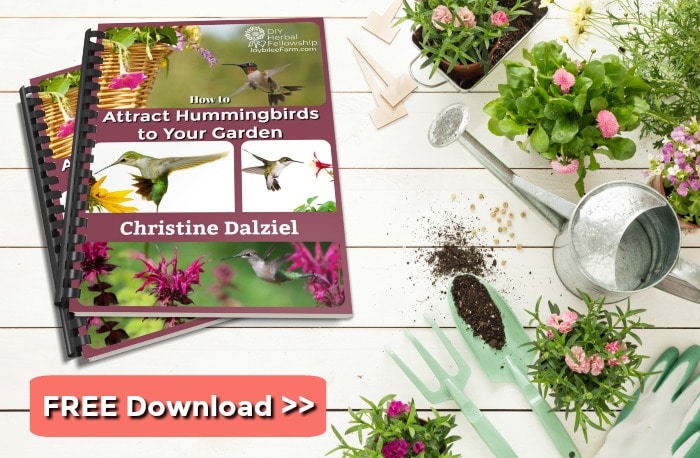


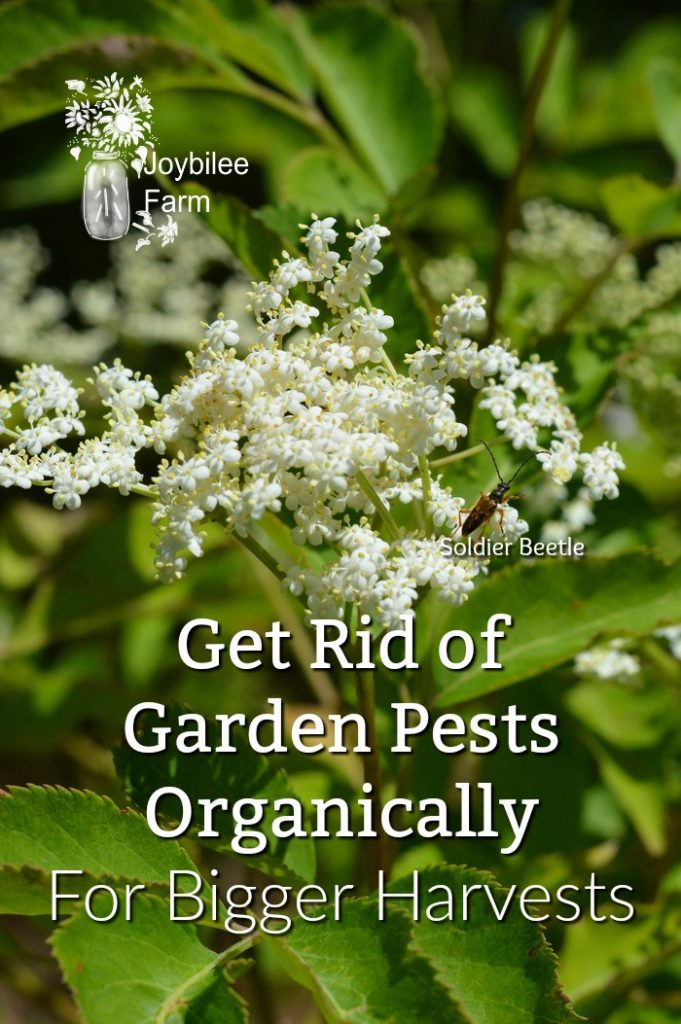

Leave a Reply